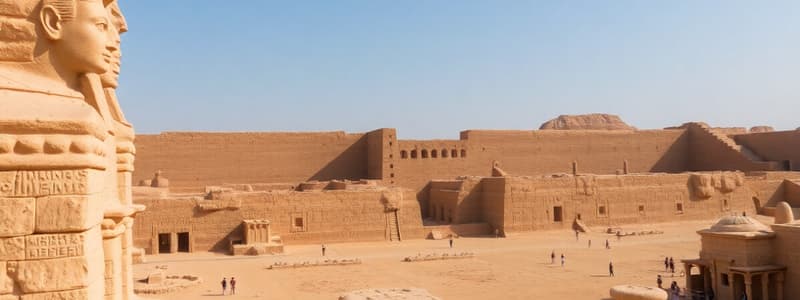Podcast
Questions and Answers
Given the discovery of the bronze sword bearing Ramses II's insignia within the Tell Al-Abqain military fort, which of the following inferences regarding the fort's strategic importance and operational capacity is most warranted?
Given the discovery of the bronze sword bearing Ramses II's insignia within the Tell Al-Abqain military fort, which of the following inferences regarding the fort's strategic importance and operational capacity is most warranted?
- The fort was principally a storage depot for royal treasures, with the sword being an isolated artifact unrelated to the fort's defensive or offensive functions.
- The fort likely served as a forward operating base, potentially equipped with on-site weapon production capabilities, signifying a critical node in Egypt's military infrastructure during Ramses II's reign. (correct)
- The fort was primarily a residential complex for high-ranking officials, with the sword serving as personal possession unrelated to military activities or strategic planning.
- The fort primarily served as a ceremonial outpost, with the sword functioning as a symbolic gesture of Ramses II's authority, indicating minimal strategic value.
Considering the archaeological findings at Tell Al-Abqain, including grain storerooms, ovens, and diverse animal remains, what conclusion can be most reliably drawn about the fort's logistical capabilities and degree of self-sufficiency?
Considering the archaeological findings at Tell Al-Abqain, including grain storerooms, ovens, and diverse animal remains, what conclusion can be most reliably drawn about the fort's logistical capabilities and degree of self-sufficiency?
- The fort exhibited significant self-sufficiency due to on-site food production and storage facilities, suggesting a capacity to sustain its population independently for extended periods. (correct)
- The fort was heavily reliant on external supply lines, indicating a limited capacity for independent food production and resource management.
- The fort primarily served as a redistribution center for resources acquired from surrounding regions, lacking any internal capacity for food production or storage.
- The fort engaged in minimal agricultural activity, with food primarily acquired through trade with neighboring settlements, indicating a dependence on external economic networks.
Given the discovery of kohl applicators and bead necklaces within the military fort of Tell Al-Abqain, which of the following interpretations best captures the nuanced understanding of daily life within the fort's garrison?
Given the discovery of kohl applicators and bead necklaces within the military fort of Tell Al-Abqain, which of the following interpretations best captures the nuanced understanding of daily life within the fort's garrison?
- The garrison exclusively consisted of elite officers and their families, who engaged in leisure activities and lavish personal grooming practices.
- The garrison maintained a purely utilitarian existence, prioritizing military functions and survival, with any personal items being strictly functional.
- The garrison's daily life was solely centered around military drills and strategic planning, with no evidence of personal grooming or adornment.
- The garrison exhibited a complex daily life that encompassed both military duties and personal practices, revealing insights into the soldiers' human experiences beyond their military roles. (correct)
If the limestone block engraved with the name 'Bay,' discovered alongside another block mentioning Ramses II, alludes to the high-ranking Egyptian official Bay who served during the late 19th Dynasty, what potential inferences could be derived regarding Bay's role and relationship to Ramses II?
If the limestone block engraved with the name 'Bay,' discovered alongside another block mentioning Ramses II, alludes to the high-ranking Egyptian official Bay who served during the late 19th Dynasty, what potential inferences could be derived regarding Bay's role and relationship to Ramses II?
Assuming that the bronze sword discovered at Tell Al-Abqain underwent metallographic analysis revealing traces of arsenic enrichment, how would this finding most likely impact our understanding of ancient Egyptian metallurgy and weapon production techniques during the reign of Ramses II?
Assuming that the bronze sword discovered at Tell Al-Abqain underwent metallographic analysis revealing traces of arsenic enrichment, how would this finding most likely impact our understanding of ancient Egyptian metallurgy and weapon production techniques during the reign of Ramses II?
Considering the context of Ramses II's extensive building projects and military campaigns, how might the discovery of the sword at Tell Al-Abqain reshape prevailing interpretations regarding the logistical and economic underpinnings of his reign?
Considering the context of Ramses II's extensive building projects and military campaigns, how might the discovery of the sword at Tell Al-Abqain reshape prevailing interpretations regarding the logistical and economic underpinnings of his reign?
If isotopic analysis of the fish and animal bones found at Tell Al-Abqain revealed a substantial proportion of species originating from distant geographical regions, what implications would this have for understanding ancient Egyptian trade networks and resource procurement strategies?
If isotopic analysis of the fish and animal bones found at Tell Al-Abqain revealed a substantial proportion of species originating from distant geographical regions, what implications would this have for understanding ancient Egyptian trade networks and resource procurement strategies?
Assuming the bronze sword's composition is analyzed, revealing a unique alloy signature distinct from other known Egyptian bronze artifacts, and further, that the inscription's epigraphy exhibits subtle stylistic variations compared to mainstream Ramses II-era inscriptions, what multifaceted interpretation could be advanced regarding its origin and authenticity?
Assuming the bronze sword's composition is analyzed, revealing a unique alloy signature distinct from other known Egyptian bronze artifacts, and further, that the inscription's epigraphy exhibits subtle stylistic variations compared to mainstream Ramses II-era inscriptions, what multifaceted interpretation could be advanced regarding its origin and authenticity?
Flashcards
Ramses II's Sword
Ramses II's Sword
A bronze sword discovered in Egypt in 2024, marked with Ramses II's insignia.
Tell Al-Abqain
Tell Al-Abqain
A 3,200-year-old military fort in northwest Egypt where the sword was found amongst mud barracks.
Sword Discovery Significance
Sword Discovery Significance
Suggests the fort was well-defended and potentially had on-site weapons production.
Purpose of Royal Insignia
Purpose of Royal Insignia
Signup and view all the flashcards
Fort's Daily Life
Fort's Daily Life
Signup and view all the flashcards
Personal Items Found
Personal Items Found
Signup and view all the flashcards
Ramses II
Ramses II
Signup and view all the flashcards
Kohl
Kohl
Signup and view all the flashcards
Study Notes
-
Egyptian archeologists discovered a gleaming bronze sword on September 5, 2024.
-
The sword was marked with the insignia of Ramses II.
-
Ramses II was one of ancient Egypt's most powerful pharaohs.
-
The sword retained its reflective shine despite being buried for over 3,000 years.
-
It was found in a small room in one of the mud barracks surrounding Tell Al-Abqain.
-
Tell Al-Abqain is a 3,200-year-old military fort in northwest Egypt.
-
The pharaoh's emblem on the sword suggests it belonged to a prominent military official.
-
Historian Peter Brand believes the sword's discovery indicates the fort was well-defended.
-
There was possibly an on-site weapons production area.
-
The sword was likely a royal gift to a high-ranking officer.
-
The king's name and titles served as a status symbol, increasing the owner's prestige and advertising the king's wealth, power, and generosity.
-
The fort revealed storerooms for grain storage and ovens for baking, indicating a self-sufficient community.
-
Remains of large clay pots contained bones of fish and other animals, suggesting a diverse diet.
-
Bead necklaces and an applicator for kohl eyeliner provided insights into the soldiers' personal lives.
-
Kohl, a dark, black powder, was used by ancient Egyptians to protect their eyes from the harsh desert sun.
-
Two limestone blocks were found, one engraved with the name "Bay," and the other mentioning Ramses.
-
Ramses II, often called Ramses the Great, ruled for 66 years, from 1279 to 1213 BCE.
-
He was the third king of the 19th Dynasty.
-
Ramses II was known for his military prowess.
-
Under his rule, Egypt's borders expanded significantly, stretching from modern-day Syria to Sudan.
-
He was also nicknamed the "builder pharaoh," and commissioned numerous temples and monuments.
Studying That Suits You
Use AI to generate personalized quizzes and flashcards to suit your learning preferences.




